Know Your Tree
Strawberry Guava
Psidium Cattleianum or P. littorale longipes
by Lew Buller
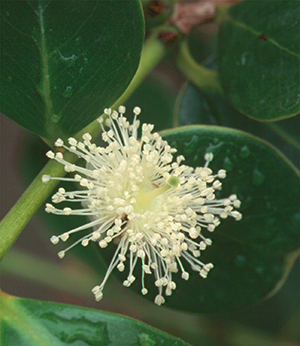
The small white flower of the strawberry guava is slightly larger in diameter than a penny. The light green tip in the flower shown, off-center to the right, is the pistil, the female part. The white spikes are stamens, the male part, and the round ball on the tip of a stamen is the anther, containing pollen. There are so many stamens that a Western Garden Book describes the strawberry guava flower as “a brush of stamens.” The strawberry guava is self pollinating. It is only necessary to have one plant, but it may do better if there are two. The plant flowers strongly in spring and sporadically in fall; in both instances the flowers are followed by fruit. The flowers are on interior leaf axils rather than on the tips of a branch, so this flowering plant is not so showy as some others.
The strawberry guava sets fruit easily and does not drop it until it is dead ripe. In the ground, the tree fruits heavily; in a bonsai pot, fruiting is lighter. Fertilizers with a little extra phosphorus and potassium give the best results and can be given to the plant pretty much year round since it is an evergreen. Fall and winter call for less fertilizer than spring and early summer, but the plants seem to thrive better if they are fertilized year round.
The entire fruit, skin and all, is edible. The skin is the color of an overripe strawberry, the flesh is white, and the taste is slightly reminiscent of a strawberry. Birds don’t care for it much, so this is one instance where the owner may get to eat the fruit. By the way, a rubber snake from a toy store, placed next to plants at risk, does a good job of frightening away birds.
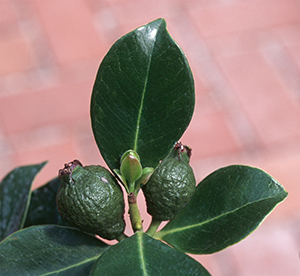
Careful examination of the picture with green fruit shows the fruit coming out of the axils of the leaves where the flowers arose. In the center, between the fruit, new leaves are growing from the tip of the branch. The tiny yellow spot on the stem at the axil of the leaf coming directly toward the viewer is a leaf bud–both flower buds and leaf buds arise at the axils of existing leaves.
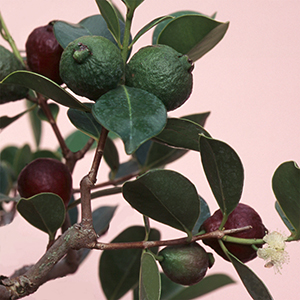
In addition to axillary leaf buds, the guava has a rich supply of adventitious leaf buds in the bark. These are triggered into growth by a severe pruning. They result in new leaves and then new branches which grow in all directions, almost at a 90o angle to the branch from which they arose. Directional pruning, along with simply removing those branches with bad angles, works best for shaping the tree because it emphasizes the angular growth; however, aluminum wire can be used to shape branches before they become too hard.
As a warm-country plant, it should be transplanted later in the growing season. Moving it from growing pot to bonsai pot may be unnerving; the plant will drop leaves and appear to die when the roots are cut severely. Defoliating at transplanting will keep the plant from being forced to drop leaves. If cared for properly, it will sprout new leaves to replace the lost ones.

Like most fruiting plants, the strawberry guava does best in a soil slightly richer than the average bonsai soil. In a pot, it takes just a little more water than other bonsai, although in the ground it is somewhat drought tolerant when established. It grows slowly, even in the ground, making a small 8-10 foot tree over time.
The 3-inch ovate leaves come down by about a third in a bonsai pot. The bark is attractive; it is a smooth gray-green that exfoliates like the Chinese elm to reveal a new, underlying reddish-brown surface. Large cuts heal well but slowly; scraping the cambium with a blunt blade will irritate it and cause it to continue to grow. Cuts should be flush or slightly concave as the cambium will roll over more heavily than junipers, for example. Cuts on branch tips should be slightly long as the cut end will die back to the next node.
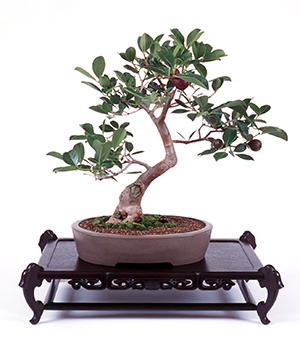
One advantage of the strawberry guava is that in the U. S. it is generally pest-free. If there is an occasional leaf-eater; either no pesticide or a mild pesticide (not a systemic insecticide since the fruit is edible) is a satisfactory solution. A pest from its native Brazil has been introduced in Hawaii to deal with the invasive stands of strawberry guava that have developed there. The U. S. Forest Service says it is one of the most destructive species ever introduced. It grows from seeds and roots and with no native pests, rapidly covered large parts of the Islands.
While there is a good deal of information on the Internet about the growth of the strawberry guava as a tree, there is relatively little information about its use in bonsai. Jerry Meislik, who lives in Montana and grows all his subtropical trees indoors, has information about his tree available. Wayne Nguyen [bonsai] has a photo of his tree but no information about it. Since I’m not duplicating any of their work, I’ll show you a little more about my tree.
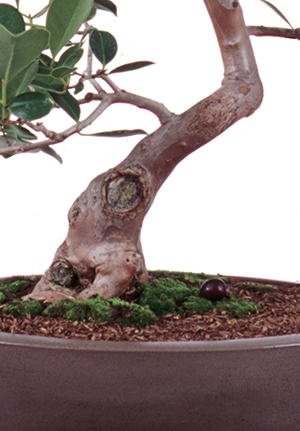
Like many of my bonsai, the strawberry guava came out of the discount section, trees no one else had been willing to buy. The large scar facing us was once a large branch that could not be bent or worked into a design. I remove the brown ring just inside the scar, take a tiny bit of cambium off with a sharp knife, and let it grow another season. Done long enough, it will result in a smooth cover.
The sharp bend upward is a branch that came from what was a sizeable branch, a continuation of the main trunk. I cut it off and over a period of several years and many trimmings and scrapings, now have a smooth elbow there. I was sorry to cut it off as branches grow slowly–you can see the two small ones coming out from the trunk. The good thing is that adventitious buds pop up all over.
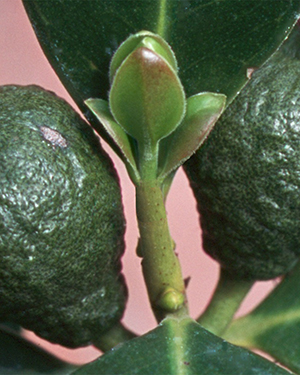
Here’s a close-up look at a bud. There’s a small green bump on the stem just above the bottom leaf. I think it’s a leaf bud. Clearly I have enjoyed growing this tree and recommend that you try the psidium cattleianum to add something different to your collection. And bon appetit.
